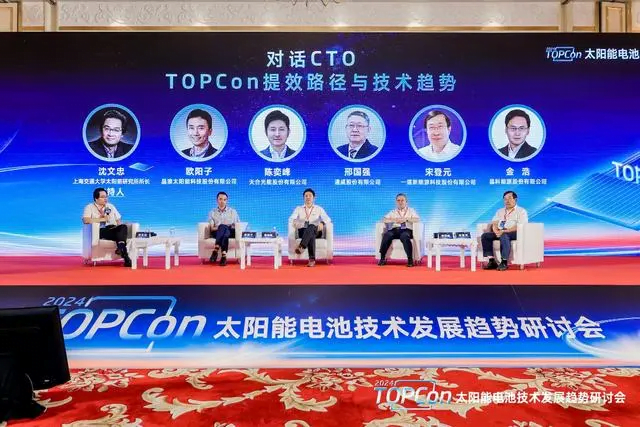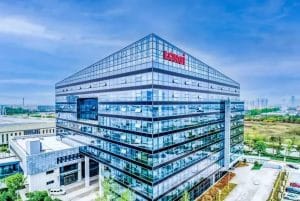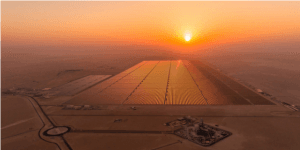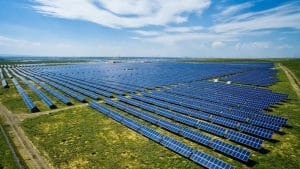Since 2024, the technology iteration and innovation of the photovoltaic industry have accelerated significantly. According to the data released by the China Photovoltaic Industry Association, in 2023, the market share of n-type battery modules is less than 25% (TOPCon is about 23%), but by 2024, the market share of n-type is expected to reach more than 70%, of which n-type TOPCon alone will account for 60%. By 2028, the market share of n-type TOPCon will still be 55.4%, maintaining its mainstream position.
While TOPCon capacity and output are growing rapidly, XBC technology is also beginning to emerge. How should different photovoltaic technologies develop? How should TOPCon efficiency be improved? How will the industry’s internal circulation end? Recently, the CTOs of five leading photovoltaic companies gave their answers.
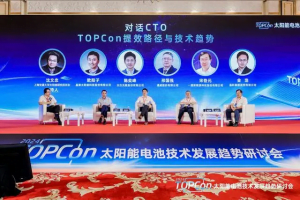
What is the secret behind n-type TOPCon’s rapid market dominance?
Dr. Chen Yifeng, Trina Solar —
TOPCon cell efficiency is more than 1.5% higher than PERC, and the power exceeds 30W. In addition, with its low temperature coefficient and low attenuation, it can bring lower BOS cost and LCOE to customers. From the current price level, the price difference between TOPCon modules and PERC modules was 0.06 yuan/W last year, and only 0.02 yuan/W this year, but the value created is far more than that, which means that most of the value is shared with customers, which is also an important reason why customers are willing to accept TOPCon.
In terms of supply chain, whether it is equipment or raw materials, TOPCon has a stable supplier system. As the saying goes, “One can walk fast alone, but a group can walk far.” TOPCon can achieve its current achievements, which is inseparable from the innovation and efforts of the industry chain group and has a huge innovation increment.
Dr. Jin Hao, JinkoSolar —
Whether it is raw materials or equipment, n-type TOPCon has more advantages than p-type PERC, and has higher theoretical efficiency. In the past two to three years, the market share of n-type TOPCon has increased rapidly, reaching 50%, 60% or even higher, which is inseparable from the support of the supply chain.
It is expected that in about two years, TOPCon single-junction cells will be able to achieve a mass production efficiency of 27%, and will continue to move towards an efficiency target of more than 28% in the future. CTM (a comprehensive evaluation index of photovoltaic system power generation capacity and stability – Editor’s note) will also continue to improve.
Tongwei Co., Ltd. Dr. Xing Guoqiang
——
The open circuit voltage of solar cells is a key indicator of technological development. TOPCon cells have shown excellent characteristics in open circuit voltage, which has gradually increased from 710mV in the early stage of research and development to 740mV in mass production now. In addition, TOPCon technology has the ability to quickly introduce mass production, with concentrated efficiency distribution and high yield. These characteristics make TOPCon technology more competitive and have broader application prospects in the market.
JA Solar Technology Dr. Ouyang Zi——
The essence of photovoltaic power generation efficiency is to maximize the absorption of light. In the battery design process, it is necessary to achieve a balance between passivation and light absorption, and the best solution at this stage is contact passivation + poly structure, with a ratio of minority carriers to majority carriers of 1:14.
As Professor Shen Hui said, technology development is the combination of process + equipment + materials. From PERC to TOPCon, the changes in process steps and equipment do not exceed 30% in total, and the conversion efficiency has been greatly improved, with extremely high cost performance. Therefore, it is a very natural choice for leading companies.
Dr. Song Dengyuan, Yida New Energy——
Yida New Energy determined the TOPCon technology route at the beginning of its establishment in 2018. At that time, the different technology routes were not as clear as they are now. Yida chose TOPCon mainly because it saw the essence of the industry. The essence of photovoltaics is energy, and the essence of energy is electricity. The technology with lower cost per kilowatt-hour may become the “boss”.
How much room is there for TOPCon to improve efficiency?
Dr. Jin Hao, JinkoSolar —
If TOPCon cells adopt the front contact passivation route, the overall efficiency will definitely improve significantly. In addition, as metallization gradually develops year by year, it changes from wide to thin, and from short to tall. When the width becomes thinner and the short becomes taller, how to better combine it with contact passivation to further reduce the contact resistance and further improve the passivation level? If this is done well, it can also bring an absolute efficiency improvement of 1%-2%.
Dr. Chen Yifeng, Trina Solar —
In the future, TOPCon must be made into double-sided TOPCon, with double-sided passivated contact. At the same time, in the future, we must pay attention to optical gain, and need to guide more light into the cell. In addition, it is necessary to reduce the loss of TOPCon cells in the half-cell cutting process.
Dr. Ouyang Zi, JA Solar —
With the introduction of new equipment and new materials, and the continuous optimization of cell structure and process, the efficiency of TOPCon technology is still steadily improving. There is no problem for TOPCon technology to maintain its mainstream position in the industry within five years.
Tongwei Co., Ltd. Dr. Xing Guoqiang——
TOPCon has just experienced 24 months of crazy efficiency improvement. It may not be so crazy in the future, but there is still a lot of room for improvement. Technologies such as high square resistance, fine grid, and double-sided poly will gradually enter mass production. We pay more attention to the technical research and development of “battery + component integration”, edge passivation is one of them, and there are other technologies to increase the power generation per watt.
Yidao Xinneng Dr. Song Dengyuan——
With the overall structure unchanged, TOPCon should have no problem achieving 27.5% efficiency. There are two main directions for improving efficiency. One is to make a fuss about thickness. Although full contact passivation has been achieved on the back, the thickness of amorphous silicon is still relatively thick, only 80nm, and the contribution to long wavelengths is poor. If it is below 50nm, the improvement in current will be relatively large. ;
The second direction is to develop new material systems. We are studying new selective carrier contact materials on the front side of the battery. Combined with different work functions, they can select holes well. We can find some materials with better contact passivation than silicon dioxide/polysilicon. If a breakthrough is achieved, it will be expected to achieve an efficiency of more than 28%.
How to find the best application scenarios for different photovoltaic technologies?
Dr. Chen Yifeng, Trina Solar —
Trina Solar’s National Key Laboratory of Photovoltaic Science and Technology has been researching IBC and heterojunction since 2010. Each technology has its own advantages, shortcomings and characteristics. The most important thing is to find a suitable application scenario and bring out other values. The front and back of the heterojunction are both passivated contacts. Its temperature coefficient and bifaciality are very good. Two problems need to be solved: one is mass production efficiency, which has not yet opened a big gap with TOPCon, and the other is equipment investment. The unit GW investment is nearly 3 times that of TOPCon. In large-scale ground power stations in the high temperature and high humidity environment of the Middle East, heterojunction has unique advantages.
The term BC technology route is not rigorous, because it includes multiple forms such as IBC and MWT. At present, the market is mainly IBC. In practice, it is also necessary to distinguish between p-type IBC and n-type TBC and HBC. TBC components have high front power and can reduce BOS costs (costs other than components, including grid access, land, cables, inverters, brackets, etc. – Editor’s note) in single-sided application scenarios, which is of certain value to customers, but for bifacial scenarios, TOPCon is more valuable.
In terms of stacking technology, TOPCon and heterojunction can be coupled with perovskite to achieve a good stacking cell structure, but IBC is a three-terminal structure, which is difficult to achieve large-scale promotion and application in engineering.
Dr. Ouyang Zi, JA Solar Technology –
R&D does not make multiple-choice questions, but there must be a focus. TOPCon is the mainstream technology, but it is definitely not the only technology. It can only be said that it has advantages in most scenarios. In scenarios where there are not many requirements for bifaciality, BC still has a “place to use”.
Including JA Solar, leading companies are very open and have not artificially set up technology gaps. For example, the aluminum oxide and silicon nitride systems that are very important to TOPCon are borrowed from PERC technology; TOPCon and heterojunction are both developing 0BB, etc. Therefore, each technology has its own advantages. Just use the appropriate one and there is no need to isolate the technologies.
There are many factors that influence empirical data. How do you view the empirical results?
Dr. Song Dengyuan, Yidaxinneng——
The requirements of the photovoltaic demonstration base are very strict. In order to test the power generation of the components, all comparison conditions must be strictly consistent. There are many factors that affect the inaccuracy of the collected power generation data, including component installation method, installation capacity, light environment, data collection method, collection equipment accuracy, data collection cycle, etc. It is recommended to refer to the Daqing base of the National Photovoltaic and Energy Storage Demonstration Experiment Platform, which has a large capacity and a long time. Even if there are errors, they are relatively uniform, and the data is more reliable.
Dr. Jin Hao, JinkoSolar——
In the past one to two years, the iteration speed of new technologies has been very fast. Overall, the newer the battery and components, the better the power generation. Even if the same TOPCon components are compared, the power generation of the new components compared to the TOPCon components two years ago may have a 2-%-3% gain. If different technical components are compared, it is related to the time stage, technology maturity, and production line control capabilities. These factors may lead to differences in power generation.
The industry’s “involution” is intensifying, how to break the deadlock?
Dr. Chen Yifeng, Trina Solar —
First, I hope the association can play a guiding and coordinating role, and leading enterprises should take responsibility, unite, promote each other, and compete in a healthy way. ;
Second, regarding the supply and demand issue, I hope to suggest limiting the expansion of low-end production capacity without technical content, especially in the investment promotion of local governments and the support of financial institutions. ;
Third, respect innovation, protect innovation, especially protect intellectual property rights, to create a better industrial ecology.
Dr. Xing Guoqiang, Tongwei Co., Ltd. —
The photovoltaic industry is experiencing the fourth fall of “four ups and four downs”, but the “U-shaped curve” will eventually go up, it’s just a matter of time and slope. The photovoltaic industry is particularly large, and its production capacity will also go through a process of survival of the fittest. Whether it is global or domestic installations, they will increase more than predicted, and ultimately achieve a rebalance of supply and demand.
The entire industry must respect and value innovation, and through effective intellectual property protection, let the R&D investment of many people produce differentiation and competitiveness, which is also a necessary way for the photovoltaic industry to develop in a healthier direction in the future.
